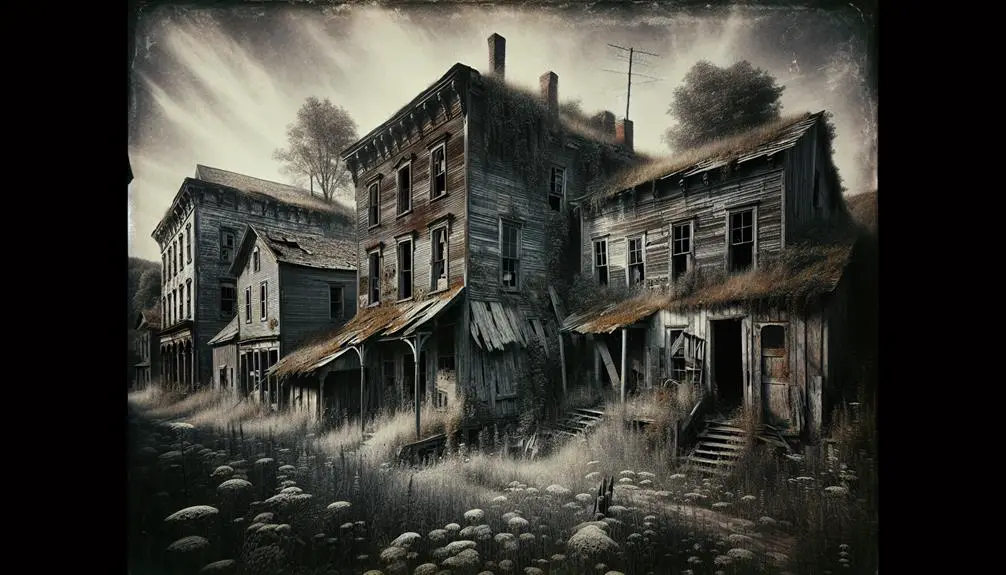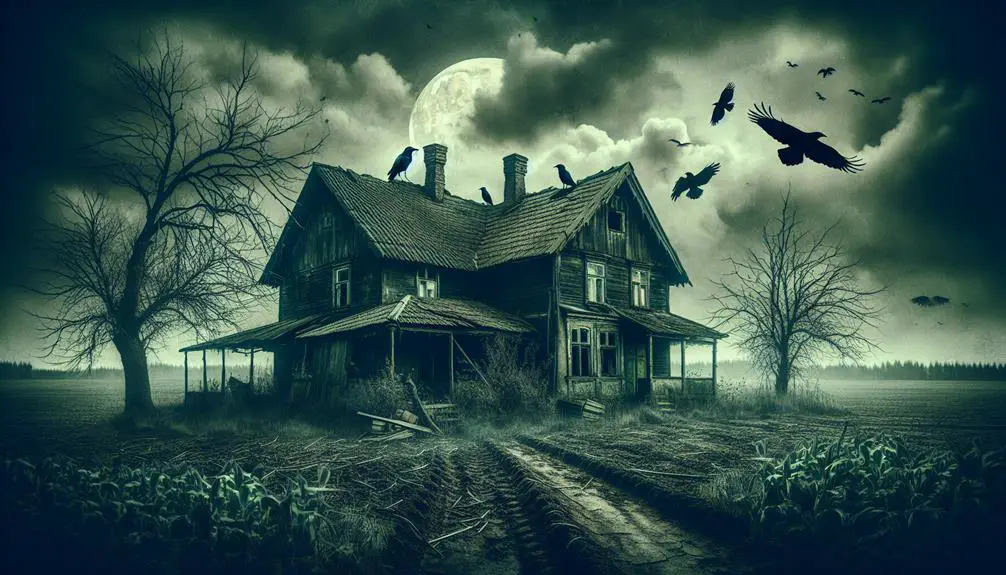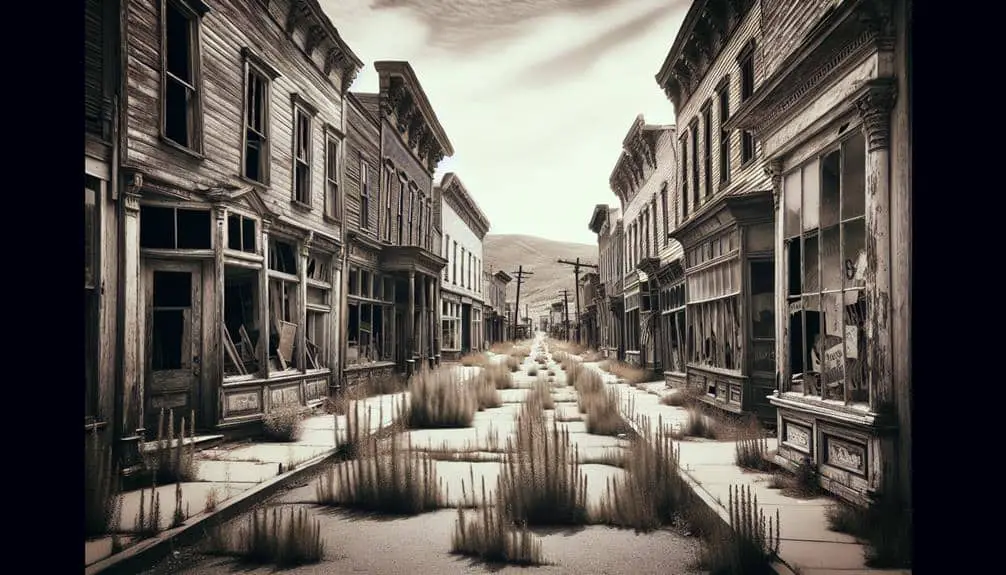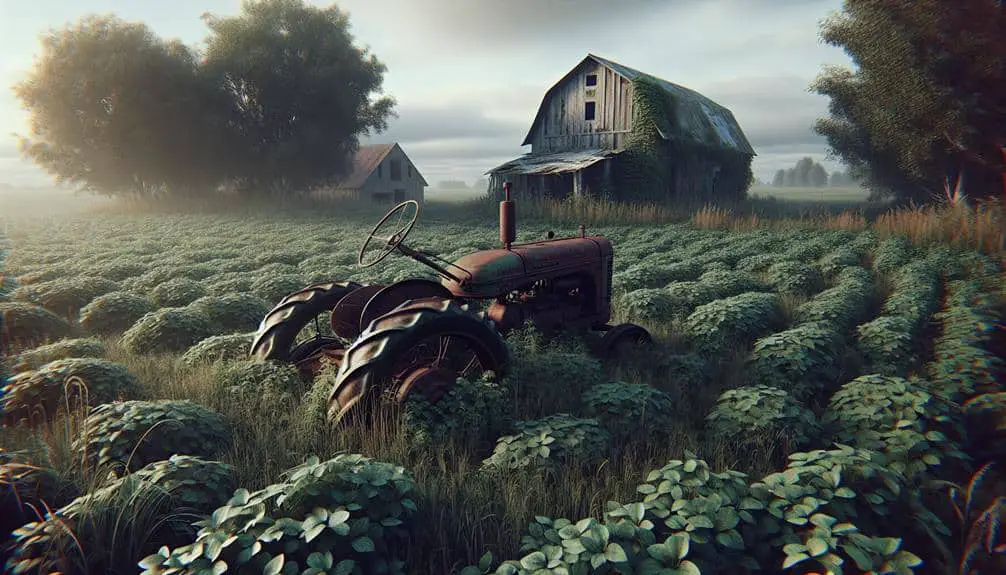Spectral rural ghost towns in the United States exist due to historical events, cultural beliefs, economic shifts, and environmental neglect. These factors intertwine to create eerie reminders of mystery, tragedy, and supernatural encounters within deserted settlements. The origins of haunting stories, economic cycles, abandoned agricultural landscapes, haunted legends, and declining industries all contribute to the enigmatic allure of these ghostly towns. These towns serve as windows into the past, reflecting a tapestry of human experiences and societal changes. Explore deeper into the layers of history and folklore surrounding these spectral rural ghost towns.
Key Points
- Historical events, folklore, and human curiosity shape haunting narratives.
- Economic cycles of growth and decline lead to deserted communities.
- Abandoned farmlands reflect urban migration and neglect, causing environmental degradation.
- Eerie legends and supernatural encounters create chilling tales in desolate areas.
- Decline in rural industries, job loss, and demographic shifts contribute to ghostly towns.
Origins of Haunting Stories
The origins of haunting stories in spectral rural ghost towns across the United States can be traced back to a combination of historical events, local folklore, and the human tendency to seek explanations for the unexplained. Cultural beliefs play a significant role in shaping these narratives, with communities passing down tales of supernatural encounters from generation to generation. These stories often serve as a way for people to make sense of the mysteries and tragedies that befell these deserted towns, providing a lens through which to view their past.
As cultural beliefs interweave with historical events, the line between fact and folklore becomes blurred, creating a rich tapestry of legend and lore. Supernatural encounters are often used to explain the inexplicable, offering comfort in the face of uncertainty. These stories not only entertain but also serve as a reminder of the enduring power of human imagination and the resilience of communities in the face of adversity.
Economic Boom to Bust
Economic cycles in rural ghost towns across the United States exhibit a pattern of rapid growth followed by a sudden decline. Urban migration plays a significant role in this phenomenon, as people move to urban centers in search of better opportunities, leaving behind once-thriving rural communities. The result is social isolation and a dwindling population in these towns, leading to economic struggles and ultimately, their ghostly status.
Historical preservation and tourism opportunities arise from the remnants of these boom and bust cycles. Many ghost towns have historical significance, offering a glimpse into the past and attracting visitors interested in exploring the remnants of a bygone era. The economic downfall of these towns may have been devastating at the time, but it has paved the way for potential revival through tourism and historical preservation efforts.
Understanding the economic shifts that have led to the creation of spectral rural ghost towns can provide valuable insights into the challenges faced by rural communities and the opportunities that lie in historical preservation and tourism.
Abandoned Agricultural Landscapes
Amidst the desolate expanses of rural ghost towns in the United States, abandoned agricultural landscapes stand as haunting reminders of a once-thriving farming past. Urban migration played a pivotal role in the abandonment of these lands. As people moved to urban areas in search of better opportunities, rural communities dwindled, leaving behind vast stretches of unused farmland. The consequences of urban migration reverberated through these agricultural landscapes, leading to neglect and eventual abandonment.
The deserted fields and decaying farm buildings also bear witness to environmental degradation. Prolonged neglect of these areas has resulted in soil erosion, loss of biodiversity, and contamination of water sources. The absence of proper land management practices has further exacerbated the environmental impact, turning once fertile lands into barren wastelands.
These abandoned agricultural landscapes serve as poignant reminders of the interconnectedness between human actions and the environment. As we reflect on the past, it becomes evident that sustainable land use practices are essential to prevent the recurrence of such desolate scenes in the future.
Haunted Legends and Folklore
Amongst the spectral remnants of forgotten rural settlements in the United States, eerie Haunted Legends and Folklore weave a chilling tapestry of supernatural tales passed down through generations. These legends often revolve around ghostly apparitions haunting abandoned buildings, mysterious lights flickering in the darkness, and inexplicable sounds echoing through empty streets. Supernatural encounters are said to occur frequently in these desolate areas, with witnesses reporting sightings of phantoms wandering aimlessly or hearing voices from the past whispering in the wind.
One such legend originates from a deserted mining town where miners who perished in a tragic accident are said to still roam the tunnels, their anguished moans echoing in the depths. Another tale speaks of a spectral woman in white who wanders the overgrown remains of a once-thriving farmstead, her presence foretelling misfortune to those who dare to cross her path.
These haunted legends and folklore serve as a reminder of the mysteries that shroud these ghost towns, enchanting the imagination of those intrigued by the supernatural and the unknown.
Decline of Rural Industries
The rural landscape in the United States has witnessed a significant downturn in its industries, leading to the gradual abandonment of once-thriving communities. The loss of jobs in traditional sectors such as agriculture, mining, and manufacturing has been a primary driver of this phenomenon. As industries modernize, they often require fewer workers, leading to widespread unemployment in rural areas. This loss of employment opportunities has forced many residents to seek work elsewhere, leaving behind ghost towns in their wake.
Moreover, changing demographics have played a critical role in the decline of rural industries. As younger generations move to urban centers in search of better job prospects and amenities, rural communities are left with aging populations that struggle to sustain local businesses and infrastructure. The exodus of younger residents further exacerbates the economic challenges faced by these areas, hastening their transformation into spectral rural ghost towns. Ultimately, the decline of rural industries underscores the need for innovative strategies to revitalize these forgotten spaces and prevent further depopulation.
Frequently Asked Questions
How Do Spectral Rural Ghost Towns Compare to Urban Ghost Towns in Terms of Haunting Stories and Legends?
Step into the world of spectral rural ghost towns, where folklore tales intertwine with historical mysteries. Urban ghost towns may boast more paranormal investigations, but rural counterparts offer unique supernatural encounters and haunting stories that captivate the soul.
What Role Do Geological Factors Play in the Creation of Spectral Rural Ghost Towns in the United States?
Geological factors, like unstable land or depleted resources, often dictate the fate of rural ghost towns in the U.S. Abandoned structures stand as eerie reminders of these influences, shaping the desolate landscapes you encounter.
Are There Any Modern-Day Attempts to Revitalize or Repurpose Spectral Rural Ghost Towns?
You can witness the heart of a small town beat again through revitalization efforts. Community engagement breathes life into forgotten streets, turning once deserted ghost towns into vibrant centers of activity and hope.
How Do Local Communities View and Interact With the Haunting Stories Surrounding Spectral Rural Ghost Towns?
You see locals in spectral rural ghost towns embrace haunting stories as part of their history. Community beliefs intertwine with local traditions, creating a unique tapestry where spectral tales enrich the fabric of these towns.
Are There Any Connections Between the Decline of Rural Industries and the Emergence of Spectral Rural Ghost Towns in the United States?
In the United States, the decline of rural industries often leads to the emergence of spectral rural ghost towns. Connections exist between economic downturns and the abandonment of these once-thriving communities, creating haunting remnants of the past.



